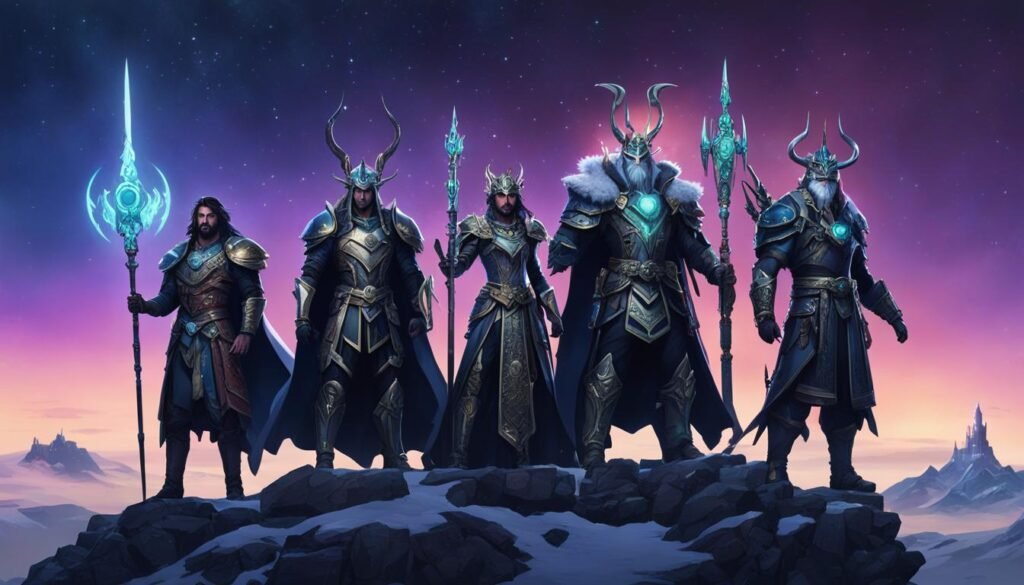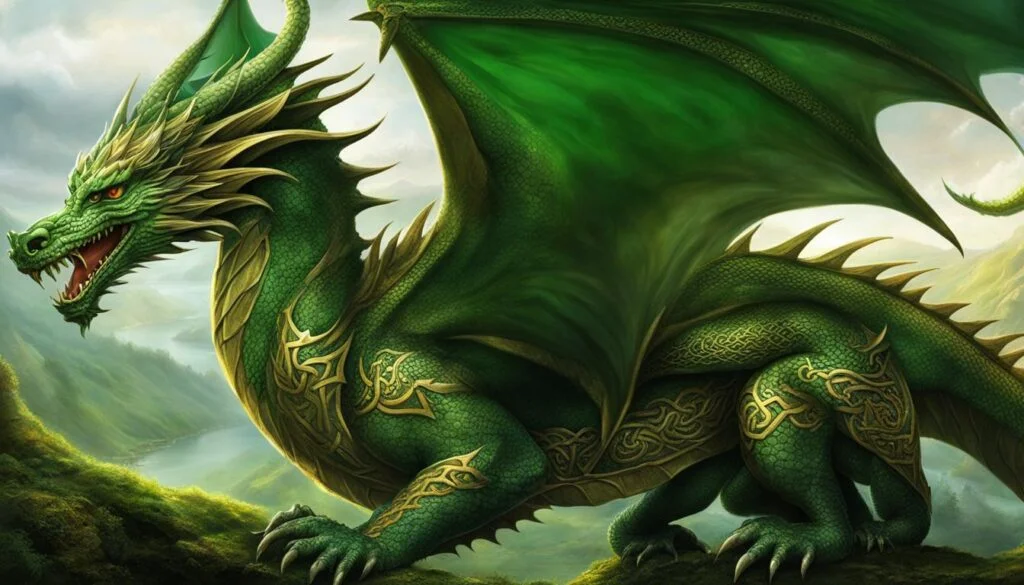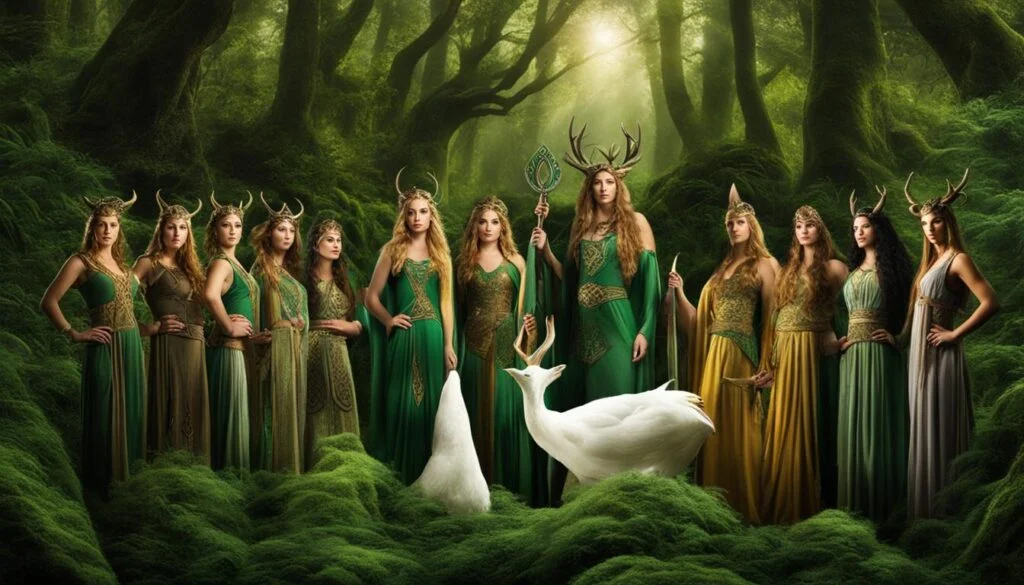What is the story of the Tuatha Dé Danann in Irish mythology? The Tuatha Dé Danann are a group of ancient Irish gods and mythological beings that play a significant role in Irish mythology. Their story is rich with fascinating tales and powers that captivate the imagination.
Key Takeaways
- The Tuatha Dé Danann are ancient Irish gods and mythological beings.
- Their story is part of the larger Mythological Cycle in Irish literature.
- They brought four mystical treasures with them to Ireland.
- Their tales reveal the complexities of Irish mythology and belief systems.
- Exploring the epic tales of the Tuatha Dé Danann allows us to appreciate Ireland’s mythological heritage.
The Four Treasures of the Tuatha Dé Danann
https://www.youtube.com/watch?v=902asUOsMQA
According to the mythological cycle of early Irish literature, the Tuatha Dé Danann brought four mystical treasures with them from the island cities of Murias, Falias, Gorias, and Findias when they arrived in Ireland. These treasures included the Stone of Fál, the Spear of Lugh, the Sword of Nuada, and the Cauldron of the Dagda. Each treasure possessed incredible magical properties and played a significant role in the mythology of the Tuatha Dé Danann.
The Stone of Fál, also known as the Lia Fáil, was a magical standing stone that was said to shriek when the rightful king of Ireland touched it. It was a symbol of kingship and sovereignty.
The Spear of Lugh, known as Gae Assail, was a weapon that never missed its target and always returned to the hand of its wielder. It was associated with the god Lugh, known for his skill in battle and as a master of many arts.
The Sword of Nuada, called Claíomh Solais, was an invincible sword that could cleave any foe and had the power to heal wounds. It belonged to Nuada, the king of the Tuatha Dé Danann, who lost his hand in battle and had it replaced with a silver one.
The Cauldron of the Dagda, also known as the Undry or Cauldron of Plenty, provided an endless supply of food and healing. It could also resurrect the dead. It was a symbol of abundance and life.
These four treasures were not only valuable items but also held immense significance and power within the world of Irish mythology. They played a crucial role in the tales of the Tuatha Dé Danann, shaping their destiny and influencing the course of their epic adventures.
The Mythological Cycle of Irish Literature
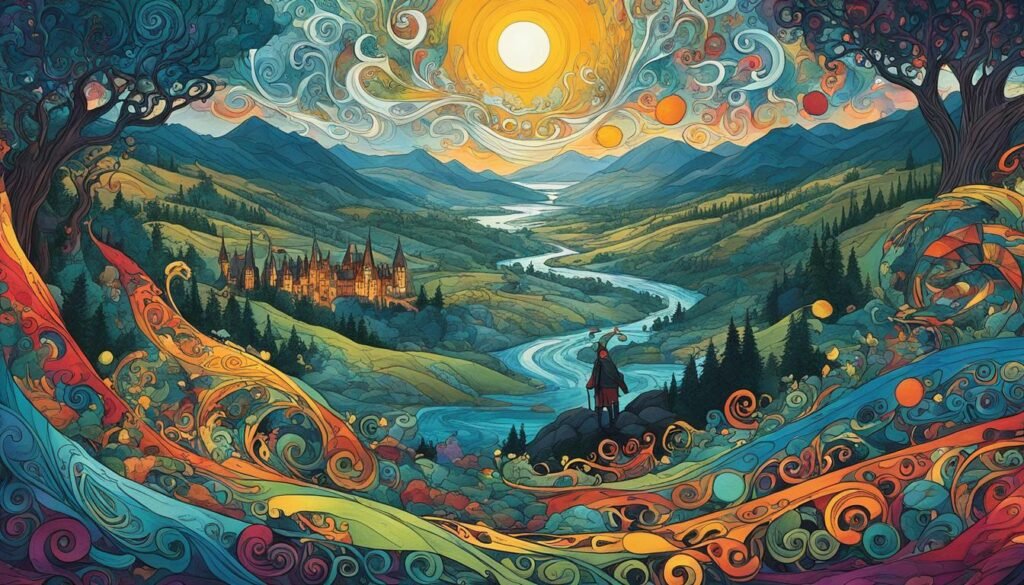
The story of the Tuatha Dé Danann is part of the larger Mythological Cycle of early Irish literature. This cycle encompasses the myths, legends, and folklore of ancient Ireland, including the tales of the Tuatha Dé Danann. The Mythological Cycle is a treasure trove of stories and provides insights into Ireland’s rich cultural heritage and beliefs.
Mythology Ireland has a long and captivating history, intertwined with ancient gods, legendary heroes, and mystical beings. Celtic mythology, with its roots in Irish folklore, is a captivating tapestry of ancient beliefs and tales that have been passed down through generations.
At the heart of Irish mythology lies the Mythological Cycle, where the legends of the Tuatha Dé Danann unfold. These mythological beings, known as the children of the goddess Danu, were powerful and otherworldly. They possessed extraordinary abilities and played integral roles in shaping the world around them.
The Mythological Cycle is a collection of myths and legends that delves deep into the realms of Irish folklore. This cycle includes stories of creation, epic battles, magical treasures, and intricate relationships amongst the deities. It offers a glimpse into the cultural heritage and spiritual beliefs of ancient Ireland.
Within the Mythological Cycle, the story of the Tuatha Dé Danann stands out as one of the most beloved and significant. They brought with them immense knowledge and artifacts from their island cities of Murias, Falias, Gorias, and Findias, shaped by irish mythology.
The image above visually represents the essence of the Mythological Cycle and its enchanting tales of gods and magical beings, with the Tuatha Dé Danann taking center stage.
As we explore the Mythological Cycle’s wonders, we uncover the rich tapestry of Irish folklore, learning more about the ancient gods and their extraordinary influence. Join us on this mesmerizing journey through Celtic mythology and experience the magic and depth of the Mythological Cycle of Irish literature.
The Divisions and Cycles of Irish Mythology
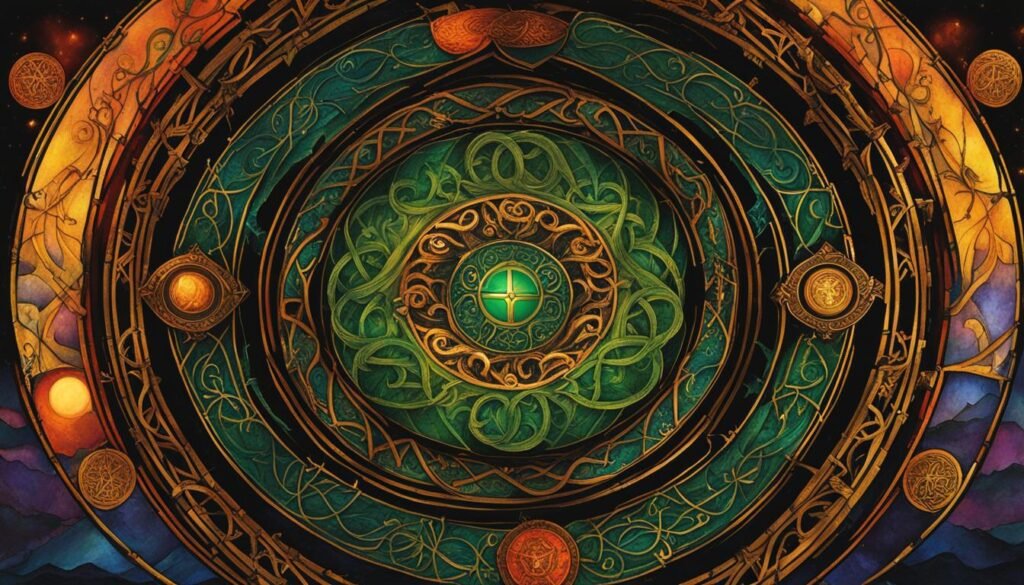
Irish mythology is a vast and intricate tapestry, encompassing a variety of cycles that offer unique perspectives on the ancient folklore and beliefs of Ireland. These cycles serve as the organizational framework for the many myths and legends that have been passed down through generations.
One of the prominent cycles within Irish mythology is the Mythology Cycle. This cycle revolves around the fascinating stories of the Tuatha Dé Danann, the ancient gods and mythological beings who played pivotal roles in Irish folklore. It chronicles their interactions with other mythical entities and gods, showcasing the magical and mystical elements of Ireland’s mythological past.
Another notable cycle is the Ulster Cycle, which focuses on the heroes, warriors, and battles of Ulster, an ancient province in Ireland. These tales highlight the bravery, skill, and legendary feats of the warriors of Ulaid, providing insight into the heroic culture and traditions of the region.
The Fenian Cycle presents a different perspective, emphasizing the stories of heroes and warriors, primarily centered around Fionn MacCumhaill (Finn McCool) and his band of warriors known as the Fianna. This cycle not only reveals tales of powerful warriors and epic battles but also explores the themes of romance and love.
The Kings’ Cycle, also known as the Historical Cycle, delves into the history and battles of Ireland’s medieval period. It focuses on the kings, bards, and significant historical events of ancient Ireland. These stories provide valuable insights into the power struggles, alliances, and battles that shaped the country’s history.
Each cycle offers a unique lens through which to view and appreciate the depth of Irish mythology, shedding light on specific themes, eras, and characters within the rich tapestry of folklore. Exploring these cycles allows us to immerse ourselves in the enchanting world of ancient Ireland and gain a deeper understanding of its mythical past.
The Mythology Cycle: Gods and Magical Beings
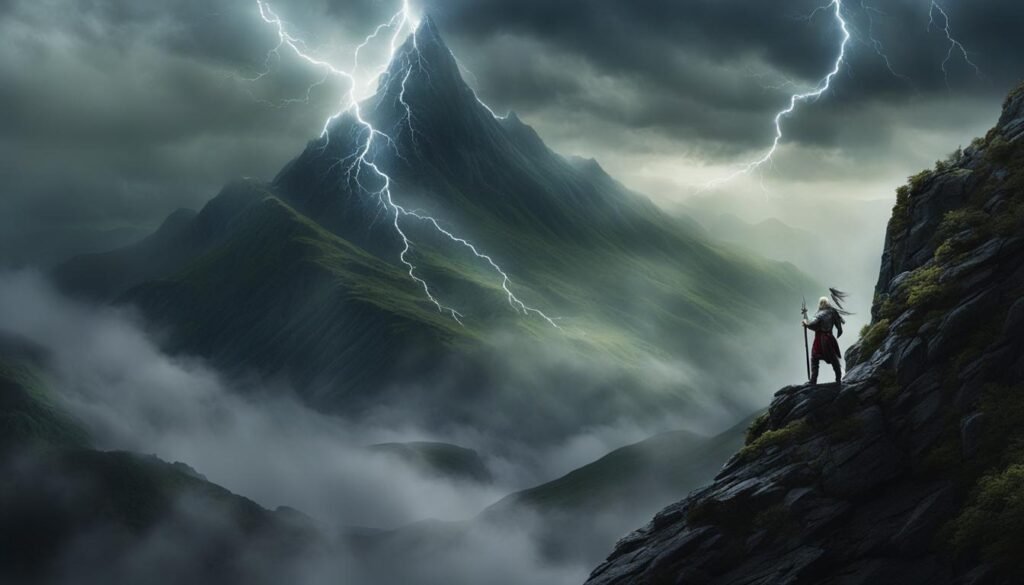
The Mythology Cycle of Irish literature delves into the world of gods and mythical beings, with a particular focus on the legendary Tuatha Dé Danann. These Irish gods and goddesses possessed extraordinary supernatural abilities and played significant roles in Irish mythology, captivating the hearts and minds of ancient Irish people.
The tales of the Tuatha Dé Danann offer a glimpse into their intricate relationships with each other and their captivating interactions with mortal humans. These mythological beings are known for their magical powers, which they used to shape the destiny of Ireland and its people. From the wise and enigmatic Dagda to the beautiful and fierce Morrigan, each deity within the Tuatha Dé Danann contributes a unique flavor to the rich tapestry of Irish mythology.
Through their stories, we witness the divine battles and alliances, the quest for power and wisdom, and the eternal struggle between good and evil. The adventures of the Tuatha Dé Danann paint a vivid picture of the spiritual beliefs and values that were held dear by the ancient Irish civilization. Their tales continue to inspire and captivate audiences to this day, as we marvel at the power and wonder of these mythical beings from Irish folklore.
The Ulster Cycle: Warriors and Battles
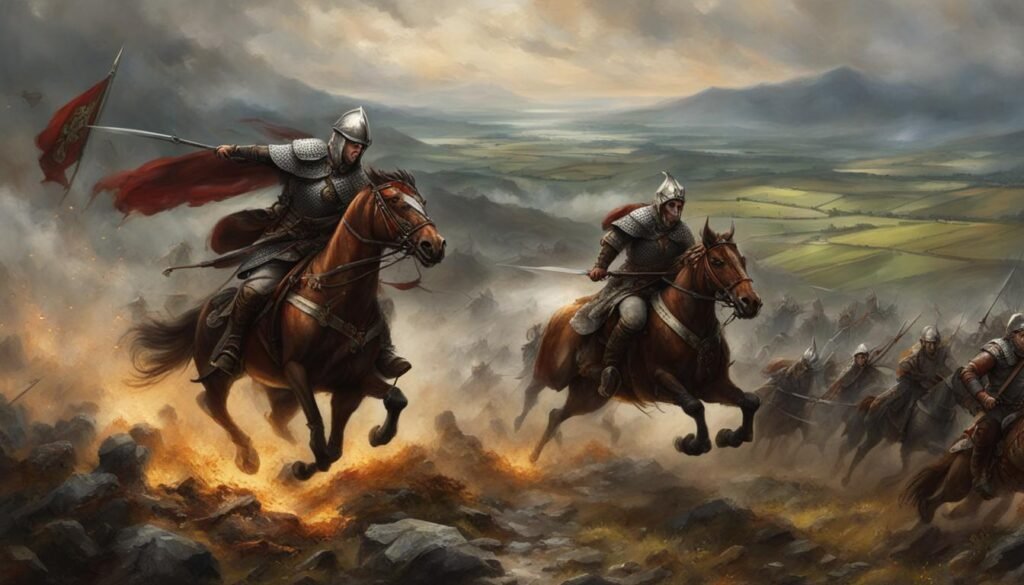
The Ulster Cycle is a collection of ancient Irish legends that revolve around the heroes, battles, and warriors of Ulster, an ancient province in Ireland. It is one of the four major cycles of Irish mythology, alongside the Mythological Cycle, Fenian Cycle, and Kings’ Cycle. The tales within the Ulster Cycle provide a captivating glimpse into the heroic culture and traditions of ancient Ireland, showcasing the bravery, skill, and feats of the warriors of Ulaid.
At the heart of the Ulster Cycle lies the epic tale of the hero Cú Chulainn, whose legendary deeds and adventures have become synonymous with Irish mythology. Cú Chulainn, also known as the Hound of Ulster, possesses unparalleled strength, skill, and courage, making him the ultimate warrior of his time. His battles, quests, and encounters with supernatural beings are the core of the Ulster Cycle and have become iconic elements of Irish folklore.
The stories within the Ulster Cycle are filled with epic battles, where heroes face formidable foes and overcome incredible challenges. Some of the most renowned warriors of Ulster, such as Conall Cernach and Fergus mac Róich, leave their indelible mark on the tapestry of ancient Irish legends. Their valor, loyalty, and strategic prowess in battle make them legends in their own right, embodying the spirit of the Ulster warriors.
From the challenge of single combat to the mythical battles against supernatural creatures, the Ulster Cycle showcases the resilience, bravery, and fortitude of the heroes of Ulaid. These warriors embody the ideals of honor, loyalty, and sacrifice, setting them apart as legendary figures in Irish folklore.
Within the Ulster Cycle, the heroes of Ulaid confront not only external enemies but also their own inner struggles and flaws. The tales explore themes of honor, fate, identity, and the consequences of one’s actions, adding depth and complexity to the overall narrative. Whether it’s the tragic tale of Deirdre, the beautiful woman who brings about the downfall of Ulster, or the exploits of Medb, the formidable queen of Connacht, the stories within the Ulster Cycle captivate audiences with their rich characters, moral dilemmas, and timeless lessons.
Immerse yourself in the enchanting world of Irish legends and discover the valor, passion, and heroism of the warriors of Ulaid. The tales within the Ulster Cycle are a testament to the enduring power of Irish mythology, weaving together history, magic, and the human experience.
The Fenian Cycle: Warriors and Romance
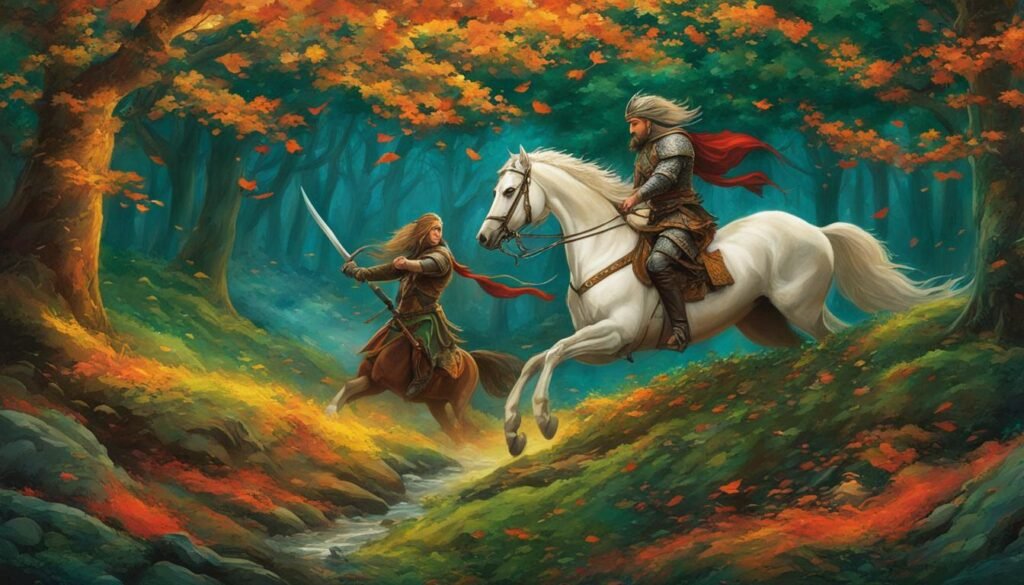
The Fenian Cycle is a captivating collection of ancient Irish tales that revolve around heroic warriors and their romantic adventures. One of the central figures in this cycle is Fionn MacCumhaill, also known as Finn McCool, a legendary hero whose exploits are celebrated throughout Irish folklore.
Fionn MacCumhaill leads a band of courageous warriors known as the Fianna, who protect ancient Ireland from various threats and adversaries. The stories within the Fenian Cycle often depict Fionn and his warriors engaging in epic battles, displaying their exceptional strength, skill, and strategic prowess.
However, the Fenian Cycle also delves into the realm of romance and love. The tales portray Fionn MacCumhaill’s romantic relationships, such as his passionate love for Gráinne, the daughter of a High King. These narratives add a layer of complexity to the characters and provide a unique perspective on ancient Irish society and its ideals of love and companionship.
The Fenian Cycle encompasses a diverse range of stories that blend elements of adventure, heroism, and romance. These narratives not only entertain but also offer insights into the values, beliefs, and cultural norms of ancient Ireland. They provide a glimpse into the lives of legendary figures who were revered as heroes and exemplars of courage.
Key Features of the Fenian Cycle:
- Heroes: Fionn MacCumhaill (Finn McCool) and the warriors of the Fianna
- Battles: Epic conflicts against mythical creatures and enemies of Ireland
- Romance: Stories of love, longing, and passion that intersect with the warriors’ heroic journeys
- Ancient Ireland: Depictions of the customs, traditions, and landscapes of ancient Irish society
The legends of the Fenian Cycle continue to captivate readers and keep ancient Irish mythology alive. The tales of warriors and romance within this cycle paint a vivid picture of a bygone era, enticing us to explore the rich tapestry of ancient Ireland’s heroes and their extraordinary adventures.
The Kings’ Cycle: Irish History and Battles
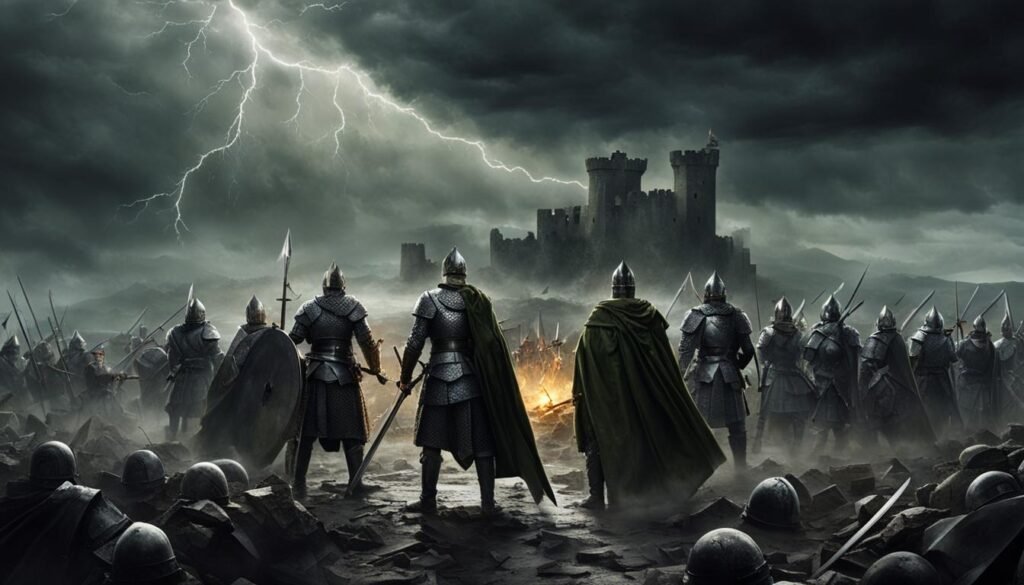
The Kings’ Cycle, also known as the Historical Cycle, takes us back to the medieval period in Ireland, shedding light on the history and battles that shaped the nation. This cycle delves into the lives of Irish kings, the role of bards, and the significant historical events of ancient Ireland. Through the tales within the Kings’ Cycle, we gain a fascinating glimpse into the power struggles, alliances, and epic battles that have left an indelible mark on Irish history.
The Rise and Fall of Irish Kings
- From the legendary Brian Boru to the High Kings of Tara, the Kings’ Cycle recounts the reigns and fates of the Irish kings who ruled over various regions of the land.
- These kings, often challenged by rival clans and external invasions, were central figures in the politico-military landscape of medieval Ireland.
- With their authority, they wielded influence over their subjects, shaped alliances, and faced the tumultuous currents of Viking incursions and Norman conquests.
The Bardic Tradition
Image: Irish kings
The Kings’ Cycle also highlights the role of bards, the poets and storytellers who played a crucial role in preserving the genealogies and tales of these royal families, ensuring their legacy endured. Through their vivid accounts, bardic narratives elevated the exploits and triumphs of kings, immortalizing their stories in the hearts and minds of the people.
Battles and Conquests
- Bloodshed and warfare defined the medieval Irish period, and the Kings’ Cycle offers a window into the epic battles that shaped the course of Irish history.
- From the Battle of Clontarf to the struggles against the Anglo-Norman invaders, these accounts provide a glimpse into the valor, strategies, and sacrifices of Irish warriors.
- These battles were pivotal in shaping the destiny of Ireland, forging alliances, guarding territories, and securing the sovereignty of the Irish kingdoms.
The Kings’ Cycle stands as a testament to the enduring spirit and resilience of the Irish people, as well as their unwavering struggle for independence and unity in the face of adversity. The tales of this historical cycle shed light on Ireland’s past, offering a glimpse into the rich tapestry of its medieval heritage.
The Mysterious Tuatha Dé Danann
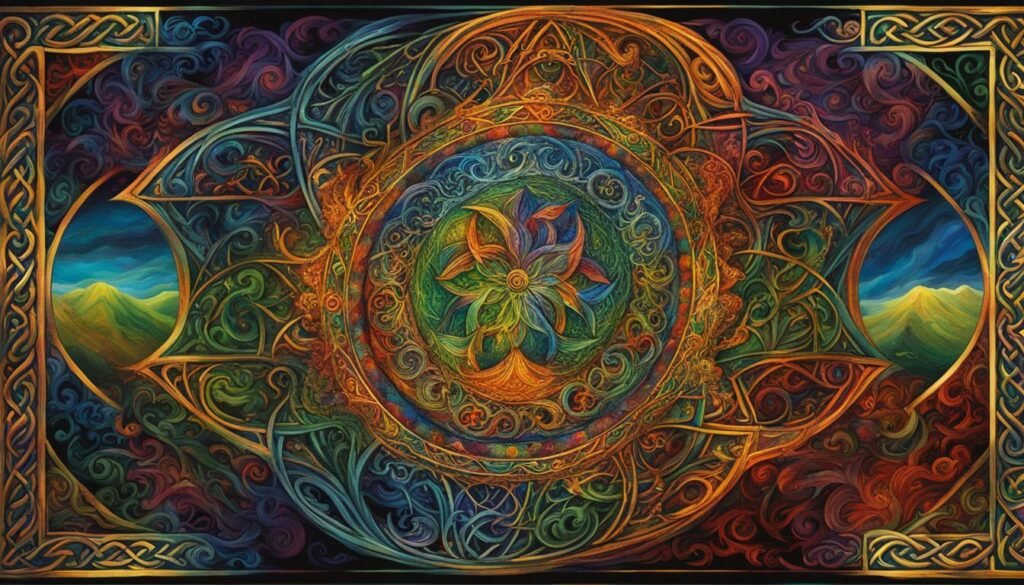
The Tuatha Dé Danann, as one of the most ancient and powerful races in Irish mythology, hold a special place in the folklore and beliefs of ancient Ireland. These magical beings have captivated the imaginations of generations with their connection to the land and their extraordinary abilities.
Known as the divine tribe, the Tuatha Dé Danann were considered gods and goddesses in Irish mythology. They possessed great wisdom, incredible strength, and vast magical powers. According to legend, they brought prosperity and abundance to the land, shaping the course of Ireland’s history.
The legends and tales surrounding the Tuatha Dé Danann are filled with mystery and wonder. They were said to have arrived in Ireland in a dense fog, descending from the skies and settling in lush landscapes. Their mystical abilities and enchanting presence made them a subject of fascination and admiration among the ancient Irish people.
The Tuatha Dé Danann were skilled in sorcery, poetry, and the arts. They were known for their mastery of transformations, shape-shifting into animals or ethereal beings. These divine creatures were deeply connected to nature and held sacred knowledge of the land and its secrets.
Legends say that the Tuatha Dé Danann possessed four great treasures that symbolized their power and status. These treasures, including the Stone of Fál and the Sword of Nuada, held immense magical properties and were sources of strength for this ancient race.
The mysteries surrounding the Tuatha Dé Danann continue to intrigue historians, scholars, and enthusiasts of Irish mythology. Exploring their stories allows us to dive into the enchanting world of ancient gods and magical beings, unraveling the deep roots of Irish folklore and cultural identity.
Conclusion
The Tuatha Dé Danann, with their captivating mythology and encounters with other mythical beings and gods, are an integral part of Irish folklore. Their stories, passed down through generations, weave a rich tapestry of ancient gods and mythological beings in Irish mythology. By exploring the cycles and divisions of Irish mythology, we gain a deeper understanding of the depth and complexity of this ancient belief system.
Delving into the epic tales of the Tuatha Dé Danann allows us to immerse ourselves in the magic and wonder of Ireland’s mythological heritage. The ancient gods and mythological beings, with their mystical powers, provide a glimpse into the enchanting world of Irish mythology and its profound connection to the land.
From the four treasures they brought from distant lands to their interactions with mortal humans, the Tuatha Dé Danann’s stories continue to inspire and captivate us. As we embark on a journey through Irish mythology, we uncover a treasure trove of legends and folklore that depict the extraordinary powers and deeds of these ancient beings.
FAQ
What is the story of the Tuatha Dé Danann in Irish mythology?
The Tuatha Dé Danann were a group of ancient Irish gods and mythological beings that played a significant role in Irish mythology. Their story is rich with fascinating tales and powers that captivate the imagination.
What are the four treasures of the Tuatha Dé Danann?
The four treasures of the Tuatha Dé Danann are the Stone of Fál, the Spear of Lugh, the Sword of Nuada, and the Cauldron of the Dagda. Each treasure had unique properties and played a significant role in the mythology of the Tuatha Dé Danann.
What is the Mythological Cycle of Irish literature?
The Mythological Cycle encompasses the myths, legends, and folklore of ancient Ireland, including the stories of the Tuatha Dé Danann. It provides insights into Ireland’s rich cultural heritage and beliefs.
What are the cycles of Irish mythology?
The cycles of Irish mythology include the Mythological Cycle, Ulster Cycle, Fenian Cycle, and Kings’ Cycle. Each cycle focuses on specific themes, eras, and characters within Irish mythology.
Who are the gods and magical beings in the Mythology Cycle?
The Mythology Cycle features gods and mythological beings such as the Tuatha Dé Danann. These powerful beings possessed supernatural abilities and played significant roles in Irish mythology.
What is the Ulster Cycle about?
The Ulster Cycle focuses on the heroes, warriors, and battles of Ulster, an ancient province in Ireland. It showcases the bravery, skill, and feats of the warriors of Ulaid.
Who are the central figures in the Fenian Cycle?
The Fenian Cycle features tales of heroes and warriors, primarily centered around Fionn MacCumhaill (Finn McCool) and the legendary group of warriors known as the Fianna. It explores heroic deeds, battles, romance, and love.
What is the Kings’ Cycle?
The Kings’ Cycle, also known as the Historical Cycle, delves into the history and battles of Ireland’s medieval period. It focuses on the kings, bards, and significant historical events of ancient Ireland.
Why are the Tuatha Dé Danann considered mysterious?
The Tuatha Dé Danann, as one of the most ancient and powerful races in Irish mythology, hold a special place in the folklore and beliefs of ancient Ireland. Their connection to the land and their magical abilities make them a fascinating subject of study.
What can we learn from exploring Irish mythology and the Tuatha Dé Danann?
Exploring the cycles and divisions of Irish mythology helps us understand and appreciate the depth and complexity of this ancient belief system. Delving into the epic tales of the Tuatha Dé Danann allows us to appreciate the magic and wonder of Ireland’s mythological heritage.


